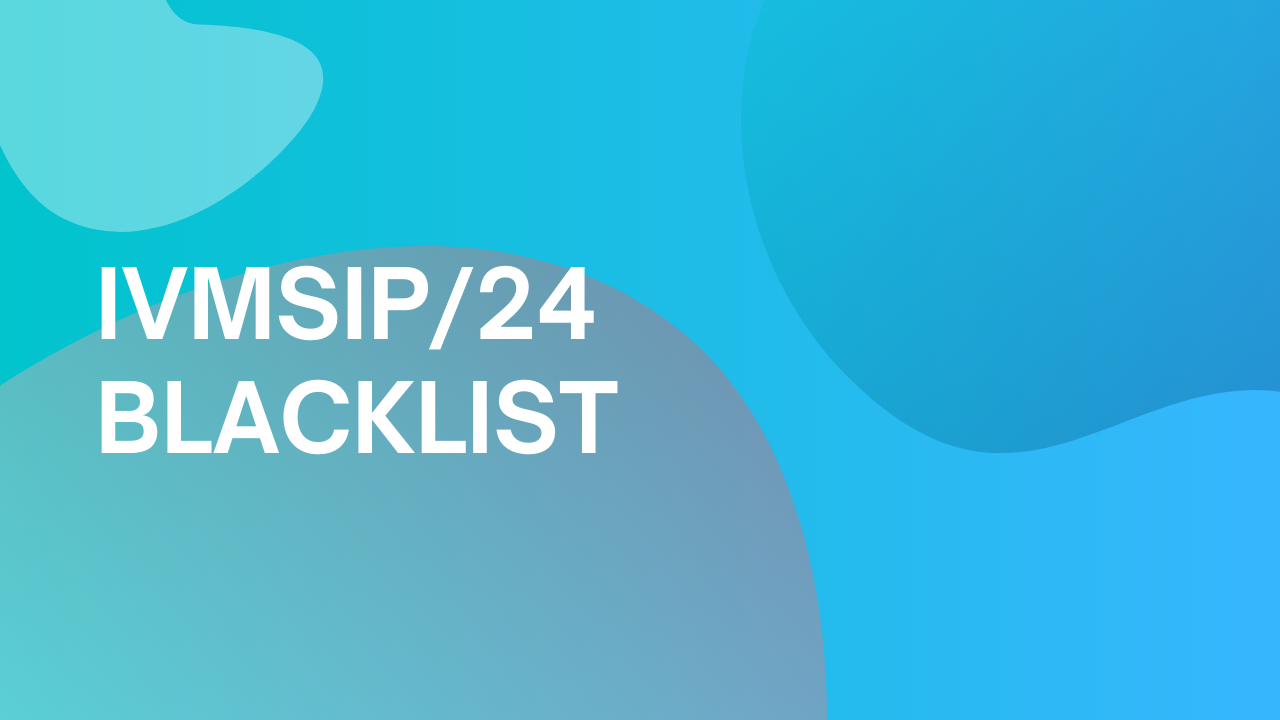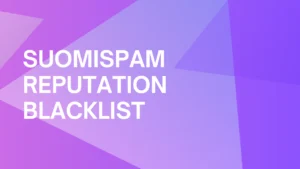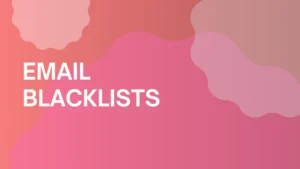
IVMSIP/24 Blacklist: What Is It and How To Remove Yourself From It
The IVMSIP/24 Blacklist flags IP addresses or entire subnets involved in sending spam. If your IP gets flagged, it can disrupt your campaigns by preventing emails from reaching recipients’ inboxes.
In this article, you’ll learn:
- Best practices to avoid future blacklisting, such as maintaining email hygiene and controlling sending volumes
- How the IVMSIP/24 Blacklist operates and why your IP might be flagged
- Steps for checking if you’re listed and how to request removal
What is the IVMSIP/24 Blacklist?
Created in 1996, The IVMSIP/24 (Invaluement) Blacklist is a specialized and well-respected list of IP addresses known for sending spam. Unlike broader blacklists, IVMSIP/24 focuses on identifying problematic IPs within specific /24 subnets—blocks of IP addresses—allowing for more precise filtering and targeting.
The IVMSIP/24 Blacklist helps email providers, administrators, and cybersecurity teams identify and block IP addresses associated with spam-sending activities.
This includes single IP addresses as well as host-provider IP ranges, helping to prevent potential threats and protect end users from unwanted or malicious content.
How does the IVMSIP/24 Blacklist work?
The IVMSIP/24 Blacklist relies on a systematic, data-driven approach to identify and mitigate spam-sending behavior:
- Data collection: IVMSIP/24 gathers information from multiple sources, including spam traps, user reports, and partner networks. Spam traps are unused email addresses specifically set up to catch spam, providing clear evidence of unsolicited activity.
- Pattern analysis: The organization conducts pattern analysis to spot recurring spam-sending behaviors. The process includes tracking emails sent from specific IPs or subnets, monitoring frequency, volume, and timing to detect consistent spam activity.
- IP flagging: Once an IP or subnet demonstrates a clear pattern of sending spam, it is flagged and added to the blacklist, including entire /24 subnets (blocks of 256 IP addresses) when widespread spam-sending behavior is detected. Doing this allows IVMSIP/24 to preemptively block potential spam sources on a larger scale.
- Subsequent monitoring: The IVMSIP/24 list isn’t static. Regular updates are key in making sure new spam sources are added while IPs that fix their behavior can be removed.
- Quality control: The process emphasizes accuracy to avoid false positives. Invaluement, the organization behind IVMSIP/24, uses rigorous checks and continuous refinement based on industry standards and feedback to maintain a high level of reliability.
- Integration with email systems: Network administrators and email service providers can integrate the IVMSIP/24 Blacklist into their spam-filtering systems.Cross-referencing incoming traffic with the blacklist lets them block or filter out emails originating from flagged IPs, safeguarding users from potential threats and unwanted messages.
Detecting and responding to blacklisted IPs
Despite your best efforts, it is still possible to end up on this blacklist. Unlike being shadow-banned on a social media site, there are concrete methods you can use to see if you’ve been affected.
How to check if you’re affected
If you’re concerned that your network or device might be flagged on the IVMSIP/24 Blacklist, it’s important to take immediate action to verify and mitigate any potential risks. These steps outline how to check, and what to do next.
1. Use IP blacklist lookup tools
Online lookup tools like BlacklistAlert and WhatIsMyIPAddress make it easy to verify your status. Be sure to check out the ‘Tools and resources’ section below for more tool options.
Once you’ve chosen your toll, just enter your IP address to see if it appears on the IVMSIP/24 or other blacklists. They provide a fast, user-friendly way to determine your standing.
2. Review email server logs
For businesses relying on email servers, server logs can reveal whether your outgoing emails are being blocked or flagged as spam.
Sudden spikes in bounce rates or delivery failures often signal that your IP has been blacklisted.
3. Set up monitoring alerts
IP monitoring services can proactively notify you if your address is flagged on any blacklist. This ongoing surveillance helps you respond quickly, minimizing disruptions to your operations and protecting your reputation.
What to do if you discover your IP is blacklisted
If you find your IP on a blacklist, don’t panic! While this situation can be alarming, there are clear steps you can take to start the removal process. The exact approach may vary depending on why your IP was flagged, so it’s important to understand the cause behind the blacklisting.
Here’s what you should do:
- Identify the source of the issue
Start by determining whether the blacklisting is due to a compromised device, a server misconfiguration, or accidental spam-like behavior (such as sending too many emails in a short time).
Then, conduct a thorough review of your email practices, server logs, and any suspicious network activity. For example, if you’ve noticed large email campaigns or sudden spikes in traffic, these could be key indicators.
If you’re unsure, use tools to check multiple blacklists (like Spamhaus, SURBL, MxToolbox, or Barracuda), as your IP might be flagged across several services.
- Disconnect affected devices
Temporarily disconnect any devices or servers that might be responsible for the suspicious activity, such as those sending spam or executing malicious tasks. This stops any further damage and prevents the risk of sending more flagged content.
- Change passwords
Reset all passwords for accounts and email servers that could have been compromised. Use strong, unique passwords for better security and to prevent unauthorized access in the future. You may also want to consider using a password manager for secure password storage.
- Scan for malware
Run comprehensive antivirus and anti-malware scans on potentially affected devices and network systems.
Malware or viruses could be sending unauthorized emails or causing other suspicious activities. Make sure to fully clean your devices before reconnecting them to the network.
- Contact your ISP or hosting provider
Reach out to your Internet Service Provider (ISP) or hosting provider. Many ISPs manage shared IPs, and they can help you investigate the issue or assist with removing the blacklist entry.
They may also offer advice on securing your network to prevent future blacklisting.
- Submit a delisting request
Once you’ve resolved the issue, visit the blacklist database’s website (like the IVMSIP/24 or others that flagged your IP). Follow their procedure for submitting a delisting request.
Be sure to provide evidence that the root cause of the blacklisting has been addressed (such as proof of cleaning devices or improving security). Some blacklists may also ask you to confirm that you’ve implemented proper safeguards to avoid future issues.
If you need to look up to see if your IP Address is on the IVMSIP/24 Blacklist, you can search here.
Simply type in up to 10 domains or IP Addresses in the text box to begin your search.
If you are on the list and want to request approval, you can search your IP address and request removal by following this link.
- Implement best practices
After successfully delisting your IP, ensure that you start using best practices to prevent future blacklisting. This includes:
Implementing SPF, DKIM, and DMARC protocols: These email authentication methods help verify your emails are legitimate, protecting your domain from being spoofed.
Regularly updating software and security settings: Keep all network and server software up to date with security patches to close any vulnerabilities.If any problems occur after an update, you always have the option to roll back a software update.
Training employees on email security: Educate your team on how to recognize phishing, spam threats, and other malicious activity to prevent accidental errors that could lead to blacklisting.
- Ongoing monitoring
Set up monitoring alerts to track whether your IP gets blacklisted again. Continuous IP monitoring services can alert you when your IP is flagged, allowing you to act quickly before the issue escalates.
Preventative measures
Staying off the IVMSIP/24 Blacklist and similar databases requires a proactive approach to network and email security. Here’s a short guide on how to avoid blacklisting in the first place:
1. Use email authentication protocols
As mentioned above, you must set up SPF (Sender Policy Framework), DKIM (DomainKeys Identified Mail), and DMARC (Domain-based Message Authentication, Reporting, and Conformance).
These protocols validate your emails and demonstrate to receiving servers that your messages are legitimate and not spoofed.
Tip: You can use our free DMARC generator and our free SPF generator to make the process quick and pain-free.
2. Maintain a clean email list
Regularly update and clean your email lists to ensure you’re only sending to valid, active addresses. Remove bounced and inactive contacts to avoid high bounce rates and potential spam complaints.
Tip: Our sister company EmailListVerify is great at list cleaning and perfect for small budgets! Give them a try and clean your email list of spam traps and hard bounces in a flash.
[Verify your emails]
3. Monitor your account(s) behavior
Keep an eye on user accounts and monitor email activity for any unusual patterns. This helps you spot compromised accounts early and prevent mass spam emails from being sent. Here are some of the behaviors to watch out for:
- Sudden spike in email activity: Unusually high volumes of emails sent in a short time can indicate a compromised account.
- Frequent login attempts: Multiple failed logins or logins from unknown IP addresses might suggest a brute-force attack.
- Logins from unfamiliar locations: Access from geographic locations that don’t align with the user’s usual activity could signal account compromise.
- Unusual email content: Sending emails with strange, spammy, or suspicious links, especially to contacts outside the user’s regular network.
- Irregular password changes: Frequent or unexpected password resets might indicate unauthorized access.
- Account forwarding rules: Changes in email forwarding settings, particularly to external accounts, can suggest an attempt to siphon data.
- Suspicious access times: Logins during odd hours, like the middle of the night for the user’s time zone, may require further investigation.
4. Secure your network:
Protecting your network requires a multi-layered approach. Use firewalls to block unauthorized access and intrusion detection systems (IDS/IPS) to monitor and respond to suspicious activity in real time.
Then, you should also deploy anti-malware tools across all devices to detect and eliminate threats like ransomware and spyware. Regularly update and patch your software to close vulnerabilities that attackers might exploit.
Segmenting your network into smaller zones based on access levels can help contain breaches, while VPNs and multi-factor authentication (MFA) ensure secure remote access.
Monitor traffic patterns for unusual activity, such as unexpected data transfers or unauthorized device connections, and enforce strong security policies to maintain a culture of cybersecurity awareness.
5. Educate your team
You can use all the safety measures in the world, but it’s often human error that causes security issues. Conduct regular training sessions on safe email practices, phishing awareness, and password security.
Keeping everyone in your organization informed of the importance of cautious online behavior can greatly reduce the risk of breaches.
6. Limit outbound email volume
Sending a high volume of emails in a short period can trigger red flags with ISPs and lead to your emails being marked as spam.
To maintain a good sender reputation, it’s advisable to start with a low volume of emails (only 30-50 per day) and gradually increase the count as you establish a pattern of safe and wanted emails.
This approach, known as “warming up” your IP address, signals to ISPs that your IP is a legitimate source of email traffic, not a source of spam.
7. Monitor IP reputation
Regularly check your IP reputation and domain status using tools like MxToolbox, SenderScore, or with Warmup Inbox. Early detection of a decline in reputation allows you to take action before blacklisting occurs.
8. Avoid spam triggers in content
Write emails that avoid spammy language and excessive use of images or links. Keep your content relevant, clear, and aligned with best practices to minimize the chances of triggering spam filters.
Following these preventative measures can help maintain your sender reputation and ensure that your network and email practices stay off the radar of blacklisting services like IVMSIP/24.
Dealing with false positives
Mistakes happen, even with highly reputable blacklist services. False positives happen when legitimate IPs are mistakenly flagged and added to blacklists. This could be due to shared hosting, compromised accounts, or suspicious traffic patterns that trigger spam filters.
Even well-maintained networks and email servers can be caught in a blacklist sweep due to perceived irregularities or errors. These false positives can disrupt email delivery, hinder communications, and damage your reputation. Knowing how to act quickly when this happens can save you from prolonged issues.
Steps to overcome a false positive
If you discover that your IP has been mistakenly blacklisted, take the following steps in addition figuring out why you’ve been blacklisted:
- Audit your network and email practices
- Review recent email campaigns, network traffic, and user activity to ensure there is no unintentional behavior that might have led to the blacklisting.
- Submit a delisting request
- Contact the blacklisting organization and provide evidence of your legitimacy. Many blacklist services, including IVMSIP/24, have a formal process for submitting delisting requests.
- Include details such as the steps you’ve taken to prevent future issues and verify that your IP is no longer a source of spam or harmful activity.
- Verify your IP’s clean status
- After submitting your request, follow up to confirm that your IP has been removed from the blacklist. Check using online tools to validate that your IP is cleared.
Monitoring after removal
After successfully removing your IP from a blacklist, ongoing vigilance is essential to avoid being re-listed:
- Regular monitoring
- Continuously monitor your IP and domain reputation using services like the ones mentioned below. These tools alert you to any decline in reputation that could signal potential issues.
- Maintain strong email practices
- Keep adhering to email best practices, such as maintaining clean email lists, using authentication protocols, and avoiding spammy content.
- Implement security measures
- Strengthen network security with firewalls, intrusion detection systems, and regular software updates to prevent malicious activity that could lead to blacklisting.
Understanding the nature of false positives and taking swift corrective action means you can protect your sender reputation and maintain uninterrupted communications.
Tools and resources to use
Maintaining the health of your IPs and network infrastructure is crucial in avoiding blacklisting issues. Here are some trusted tools and resources to assist you in monitoring and protecting your network:
IP blacklist checkers
- MxToolbox: Offers comprehensive blacklist checking services to identify if your IP or domain is listed on any known blacklists.
- Spamhaus: A reliable resource for checking if your IP address has been flagged as a spam source.
- BlacklistAlert: Allows quick checks for IP and domain blacklisting across multiple lists, providing detailed reports on the status and reason for blacklisting.
- IPVoid: Another free tool that scans your IP against more than 90 known databases to identify potential blacklisting.
- GlockApps: Provides insights into your IP reputation and detailed reports on inbox placement, helping ensure your emails are not landing in spam folders.
Network security solutions
- Firewalls and Intrusion Detection Systems (IDS):
- Cisco Secure Firewall: Offers robust firewall solutions that monitor and block suspicious activity in real-time.
- Snort: An open-source intrusion detection system capable of identifying malicious network behavior and preventing breaches.
- Email security solutions:
- Mimecast: A comprehensive email security tool that prevents phishing, malware, and spam from reaching your network.
- Proofpoint: Protects your email system from threats and helps maintain compliance and reputation.
- Security Information and Event Management (SIEM):
- Splunk: A powerful SIEM tool that provides real-time data analysis, log management, and alerting to identify and address potential security issues.
- IBM QRadar: Offers advanced threat intelligence and security analytics to detect vulnerabilities that could lead to blacklisting.
- Reputation management services:
- SenderScore: Monitors your email reputation and alerts you to any drops that could lead to blacklisting.
Conclusion
Avoiding blacklisting issues starts with staying proactive and keeping a close eye on your email activity and network security. By using the right tools and sticking to best practices, you can reduce the risk of disruptions and keep things running smoothly.
Strong security measures and regular monitoring don’t just protect your network—they also help you build trust and maintain the reliability of your digital communications.
Related terms
Blacklist: An online database that aggregates email addresses and domains that have been reported on multiple occasions to be sending out spam or malicious content to others on a large scale.
These blacklists are used as a reference by mail servers in order to determine how safe it is to accept messages coming from unknown domains and addresses.
IP address: Internet Protocol is a unique address that identifies a device on the internet or a local network.
IP is the set of rules governing the format of data sent via the internet or local network.SORBS Spam Blacklist Removal: The process of delisting an IP address from the SORBS Spam Blacklist, which blocks IPs involved in spam, phishing, or malware. Removal can be requested through the SORBS website.



